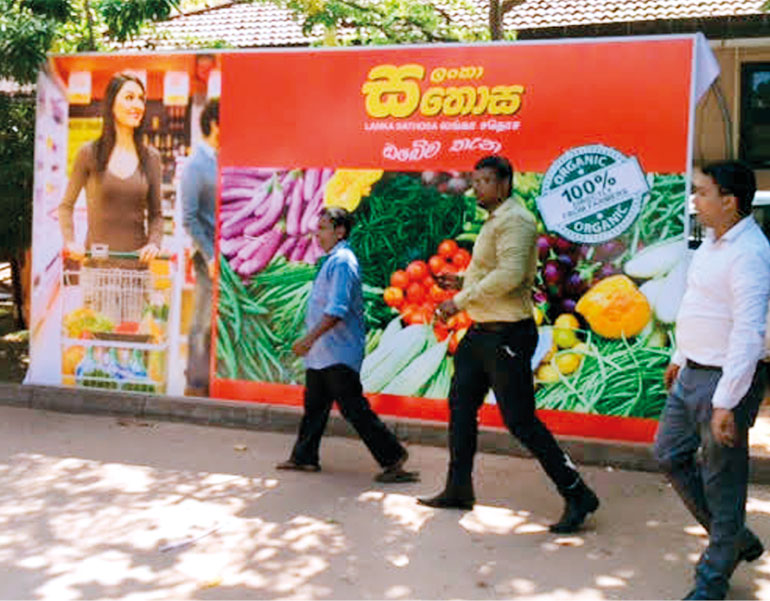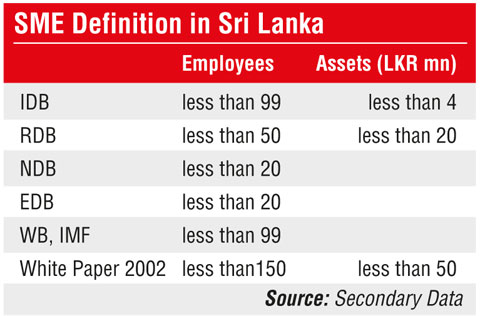Wednesday Apr 16, 2025
Wednesday Apr 16, 2025
Tuesday, 12 April 2016 00:05 - - {{hitsCtrl.values.hits}}
SMEs, which accounts for over 73% of the economy, are intriguing given that all we see in the papers are large companies and multinationals. This means that over one-third of the economic activity gets unaccounted.
The reality
SMEs generate more than 70% to Sri Lankan GDP and comprise over 70% of exporters but we never see this sector in any of the glitzy magazines or the financial section of any of the newspapers, even though in money terms they account for a colossal $ 45 billion plus or more. It may not be incorrect to say that they are the forgotten entity of the Sri Lankan economy.
 The SME shopper behaviour survey reveals that Sathosa outlets are part of their behaviour
The SME shopper behaviour survey reveals that Sathosa outlets are part of their behaviour
Definition of an SME
One problem in this sector is that there is no proper definition of what an SME is. The problem is not unique to Sri Lanka, but is common to many countries around the world, as classifying an SME can be on a multitude of variables that can vary from one country to another. Further, the absence of data in this uncontrolled sector of the economy adds to the complexity.
In Sri Lanka, some say that an enterprise which has less than 99 people and an asset base of four million can be termed an SME. Then another definition is less than 50 people but an asset base of 20 million. The World Bank  states that if any enterprise has less than 99 people, it can be termed an SME. Hence it is very clear that this is one key decision that Sri Lanka needs to take as a country given that concessionary financial facilities can be targeted as well as availability of specific business development services can also be made available if there is a clear classification of an SME.
states that if any enterprise has less than 99 people, it can be termed an SME. Hence it is very clear that this is one key decision that Sri Lanka needs to take as a country given that concessionary financial facilities can be targeted as well as availability of specific business development services can also be made available if there is a clear classification of an SME.
Apart from the fact that over 70% of GDP is generated by SMEs, another important point to note is that from the 4,700 odd exporters that generate almost eleven thousand billion rupees, nearly 80% of them are SMEs.
If we take another sector like the tea industry, from the 300 million kilograms of tea that Sri Lanka produces, almost 70% of them are from the small holding producers that have just half an acre of land area. Hence we see that there are many unsung heroes in the SME business who never get highlighted or for that matter identified so that development can be done from a State perspective.
How SMEs came into being
If I may take you back to how the SME sector evolved in Sri Lanka, apparently way back in 1952, the World Bank had suggested that the Government develop SMEs rather than promoting large industries. Then in the 1960s the Sri Lankan Government began focusing on developing cottage industries and SMEs for the sole purpose of saving foreign exchange through import substitution and to spruce up employment. Thereafter, in the 1977 post-liberalised economy, SMEs were developed to drive the export market, which is actually when the SME sector was unleashed to become the backbone of the country’s economy.
With this development came the multitude of Government agencies and private sector banks that were being set up to provide the policy environment to support this fast-developing business sector. This included the Department of Small Industries, CISIR, EDB, SLSI, IDB, SLECIC, Textile Department, National Gem and Jewellery Authority, NEDA, DFCC, NDB, SME Bank and later renamed as Lankaputhra and today, the powerful bank called Regional Development Bank (RDB) to name the key institutions. In the recent past we have seen many line ministries like the Ministry for Traditional Industries and Small Enterprises coming into the fray, which explains the fast growing importance of this sector.
Challenges for Sri Lanka
Visiting some of the SMEs in different parts of the country, one of the key issues that was cited was that there is no clear policy for a typical small and medium scale entrepreneur to be guided. Some SMEs in Ekala said that if one is to register property, it takes almost 258 days and 5% of the land value, which is not conducive to foster entrepreneurship. I guess that is why Sri Lanka’s rating in the Ease of Doing Business Index is way below that of a country that demonstrates 6% GDP growth.
Some went on to say that very few business development services are available such as research and development facilities, quality certification at district level and the linkage to export markets. Most SMEs harp on the difficulty in having access to concessionary finance, this being the key hindrance to business development.
Another point highlighted by the SMEs is that almost 60 types of taxes have to be paid to a bank during a year, which is very cumbersome and time-consuming and it must be a priority item that must be addressed. Some went on to say that a typical SME being stretched for talent results in these archaic tax systems affecting the productivity of the organisation.
Indian SMEs – 25 to 332 million
If I may cite an experience shared at the recent SME conference that was staged in India, in year 2002-03, there were around 24.9 million SMEs in India but with key changes to policy on the lines discussed above, the progress  has been phenomenal. As at today, the number stands at 332 million SMEs as per the statement by the Minister of Small Scale Industries – Agro and Rural Sector. The Secretary of the said Ministry went on to say that with minimum policy changes, the greatest results were being achieved, given that there was a passionate commitment to drive strategy. I guess we need to pick up a few lessons from this experience.
has been phenomenal. As at today, the number stands at 332 million SMEs as per the statement by the Minister of Small Scale Industries – Agro and Rural Sector. The Secretary of the said Ministry went on to say that with minimum policy changes, the greatest results were being achieved, given that there was a passionate commitment to drive strategy. I guess we need to pick up a few lessons from this experience.
Way forward for Sri Lanka
The first key task is for this sector of business to have a single line ministry. This can result is a clear and focused agenda that can be developed which will be followed by a set of policy guidelines. If this is done, some of the key issues highlighted can be addressed straightaway with minimum impact to the tax revenue model of the country.
Secondly, a SME Policy Unit must be set up so that very close contact can be made with the SMEs, which will result in an updated database which will make the task of developing specific business strategic possible. This can also lead to a once-a-month SME forum to be organised where the key obstacles that SMEs are faced with can be highlighted so that a PPP model of problem solving can be applied just like the ‘Samatha Piyasa’ Exporters Forum that was staged at one time at the EDB.
Thirdly, support linkages can be developed with ITI, EDB, SLSI and the Department of Registration so that at regional level too this service can be accessed by a typical SME.
Fourthly, the issue of access to finance must be addressed. This can only be done if financial rigour is being practiced by the SMEs so that when it comes to documentation required for one to take a loan, things are in order. Maybe the Regional Development Bank can have a unit that helps SMEs structure their documentation in a way that access to finance is possible even if the cost of the capital is not as attractive, the logic being that even if interest rates are reduced to levels that are very attractive, if financial discipline is not being practiced by an SME, access to finance will still remain an issue.
Finally, maybe we need to drive industrial estates in different parts of the country but in a sector specific manner, just like in India, so there is greater focus and stronger networking that leads to the industry as a whole becoming very competitive. This can also help drive specific technology that can be shared by the different competitors as well as the employment can be targeted by sector.
Conclusion
Given the thrust of China driving the swap of debt and robust tourism industry – be it Shangri La, Hyatt, Movenpick or Avani – we have to focus on a robust strategy of developing SMEs so that regional disparities can be cut and poverty issues in places like Moneragala, Mannar and Mullaitivu can be corrected, but more importantly it will quicken the pace at which Sri Lanka crosses the 4,000 dollar per capita income. The challenge is how each of us can contribute to this developmental agenda.
(The author can be contacted on [email protected])